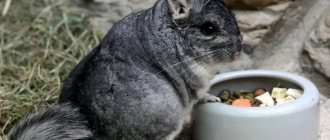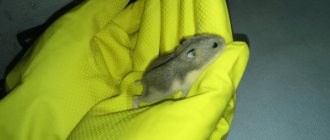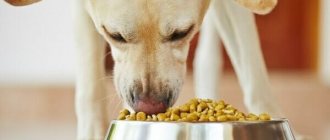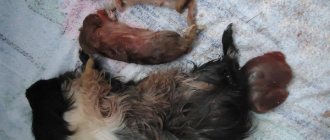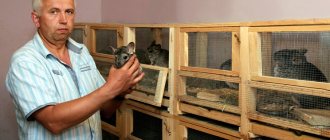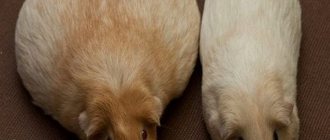This article will talk about breeding chinchillas at home and the rules for giving birth.
On the one hand, this is a profitable business that does not require large upfront costs, on the other hand, it is an exciting hobby. Indeed, today these animals are considered not only as a source of valuable fur, but also as pets, which are often bought for city apartments or private houses. But before breeding chinchillas, you should familiarize yourself with special literature, study the features of their maintenance, breeding, raising young animals and take care of creating the necessary conditions.
How to tell if a chinchilla is pregnant
In the early stages, pregnancy in these big-eyed animals is practically invisible. Mating occurs at night, and a young primiparous individual may not have a plug at all. For successful mating, partners need to be seated correctly so that there is no mutual aggression and hostility among the animals. A reliable sign that a female has become pregnant is that she has not gone into heat for a month.
ATTENTION! Despite early puberty, it is not recommended to board animals under 12 months of age.
Early pregnancy leads to:
- Stopping the development of the female;
- pathologies of embryo development;
- severe pregnancy;
- miscarriages;
- death of cubs at an early age;
- general weakening and health problems in the female.
Characteristic signs of pregnancy in a chinchilla
From the 8th week of a pregnant chinchilla, even a novice breeder will be able to determine the presence of pregnancy. To begin with, you should pay attention to the animal’s nipples. In a non-pregnant animal, they do not stand out and are not felt when stroking the fur. And already from the fifth week of pregnancy, the nipples of a pregnant female begin to swell, turn red and stand out. In the last weeks before giving birth, white colostrum may be released from the nipples.
REFERENCE: Pregnancy is the period of pregnancy in chinchillas.
Pregnant females have an increased appetite
Increased rodent appetite
A pregnant female chinchilla, like any other animal, has an increased appetite. She drinks and eats much more often, as developing puppies need nutrition, proteins and microelements. This is also one of the signs that the animal is pregnant.
Changing the appearance of the nipples
During pregnancy, the female's nipples stand out from the fur, change their color and become more sensitive. As a rule, lactation occurs from only one pair of nipples. The whitish discharge in recent weeks is called colostrum and is not dangerous.
Animal weight gain
Naturally, if there are embryos, the weight of the chinchilla will increase. The weekly increase can reach up to 15 grams. It is recommended to carry out control weighings every week to monitor the progress of pregnancy and record the scale readings on paper or electronically. It is not recommended to take the animal by the tail for weighing. This can cause premature birth or miscarriage. At a later stage, weighing is no longer performed so as not to expose the female to additional stress.
Increased urination
A pregnant animal performs many more acts of urination compared to the pre-pregnant period. This is due to the fact that the enlargement of the uterus leads to compression of the bladder and an increase in the number of urges.
After 90 days of pregnancy, you can feel the babies in your stomach
Abdominal enlargement
The rounding and enlargement of the tummy is clearly evident from the 8th week of pregnancy of the chinchilla. With the further development of pregnancy, fetal movements can be observed with the naked eye. After 90 days, you can already feel the cubs in the mother’s belly with your hand. But in order not to provoke a miscarriage, it is not advisable for owners of furry animals to do this.
Changes in the behavior of a pregnant female
Pregnant chinchillas become less and less active as pregnancy progresses. At the same time, they will be noticeably calmer and more affectionate towards their owner. The animal sleeps more often on its side; in later stages, you can observe the female sitting on her back. Before the onset of childbirth, the female becomes restless, frightened by sharp sounds and shows aggression towards the male.
Ultrasound diagnostics and radiography
Ultrasound diagnostics when an animal becomes pregnant is needed to confirm this fact and exclude obvious pathologies. X-rays are carried out in the later stages of pregnancy to determine the number of cubs, when their skeletons are already ossified. Also at this time they look at the presentation of the fetuses. If you have any questions or concerns, you should immediately contact your veterinarian. You should not give your animal medications on your own without a prescription.
Loop change
Before giving birth, the female's external genitalia become red and increase in size. The male may perceive this as estrus and try to mate with a pregnant chinchilla. And sexual intercourse during pregnancy can cause a miscarriage or other problems during pregnancy. Therefore, it is recommended to place the male in a separate cage for several months a couple of weeks before the expected date of birth.
If the owner notices purulent discharge from the loop, a change in the behavior or appetite, as well as the activity of the pregnant chinchilla, then you should immediately take the animal to a qualified veterinarian, who will determine the possibility of maintaining the animal’s pregnancy or perform an emergency cesarean section. In this case, the question of the life of the cubs no longer arises; the mother is saved.
It is better to disturb a pregnant woman as little as possible
How long does pregnancy last
Depending on the individual characteristics of the female’s body and the number of puppies being carried, a chinchilla’s pregnancy can last from 105 to 120 days. In young females, gestation is longer. This is due to the fact that the fewer babies a chinchilla has, the longer it bears them. And in the first litter, as a rule, there are no more than 2 puppies. Then the chinchilla mother is pregnant for 115-120 days.
Older females can give birth to 5-6 babies at once. And their gestation period is only 100-105 days. It is worth noting that during multiple pregnancies, newborns are born with closed eyes and a small amount of fur. While chinchillas from a small litter, as a rule, are immediately sighted, stronger and covered with thick fur coats.
How to care for a pregnant chinchilla
To minimize stress in a pregnant female, it is necessary to provide her with silence, dim lighting and generally calm conditions. Harsh sounds, bright lights, and frequent contact with people will provoke anxiety and may even cause miscarriage. It would be optimal to maintain silence in the room where there is a cage with a female and try to handle her as little as possible.
To avoid injury to the female, experts recommend removing all shelves, toys and stairs during pregnancy. The cage must be cleaned daily, using hay or special wood filler for bedding. It is also better to keep the animal’s walks to a minimum so that nothing can scare the animal.
What to feed a pregnant chinchilla
Despite the increase in the animal's appetite, you should not feed a pregnant chinchilla. But at the same time, you should make sure that her diet is high-calorie and varied, with the necessary content of all the necessary beneficial microelements, proteins and vitamins. It is better to exclude hay and dry food from the diet, replacing them with fresh fruits, vegetables and foods high in protein.
This will have a beneficial effect on the female’s digestion and will provide maximum benefits for the development of the offspring. It is also worth closely monitoring the constant availability of fresh drinking water, which the female consumes much more during pregnancy than usual. It is recommended to exclude foods that cause flatulence and those that can lead to poisoning.
Otherwise, the animal’s diet is the same as before pregnancy. Is your chinchilla already pregnant?
Puberty and mating
Most chinchillas experience their first heat at 4-5 months. By this time, the female reproductive system is ready for fertilization. But an incompletely formed organism will not cope with bearing puppies and giving birth. Therefore, early fertilization can lead to the following adverse consequences:
- exhaustion of the female’s body;
- miscarriage;
- birth of stillborn cubs.
Veterinarians recommend that chinchillas begin mating at the age of 8-9 months for females and 6-7 months for males. And in order to minimize complications during childbirth, it is better to postpone the birth of the couple until they are one year old.
It is necessary to carefully prepare for the process of mating animals. First, you will need to introduce potential partners by placing them in 2 cages, standing at a distance of 15-20 cm from each other. When the fluffies get used to the sight and smell of each other, you can briefly place the female with the male.
In the absence of aggression, it is allowed to leave animals together for 3-4 hours a day. By the time of estrus, the couple should become friends. The female's loop will indicate readiness for mating - it will become wet, open slightly and acquire a rich pink hue. At the same time, the behavior of the male will change - he will show signs of attention, make inviting sounds and, most importantly, make attempts to cover the girl. Typically, sexual intercourse in chinchillas occurs at night and lasts only a few seconds.
The fact that everything went well will be signaled by the male’s fur and dried seminal fluid scattered around the cage. To be sure, you can leave the couple together for another 2-3 days.
How does childbirth go?
This issue is especially troubling for novice pet owners who are afraid of missing a crucial moment. But there are a number of signs that will let the owner know that the animal is about to give birth.
Signs of approaching labor
Before giving birth, the female chinchilla becomes more restless and aggressive, afraid of any sound or light. If the male is still in the same cage with her, then the pregnant chinchilla will attack him before giving birth. If all sources of stress are not eliminated, a frightened animal may give birth prematurely or kill and eat its offspring.
A few days before the crucial moment, the female begins to build a nest, chopping straw and hay and pulling out her fluff. If suddenly this does not happen, then the owner should himself provide a nest or nesting house for the expectant mother and her cubs. During this period, the female moves little, often arches her back, and can even crawl along the floor. This helps move the puppies closer to the birth canal.
Immediately before giving birth, the female's abdomen drops, the ribs are retracted and the loop becomes red and greatly enlarged. The female's weight and temperature may also decrease.
How to prepare
Before giving birth you must:
- Place the male or female in advance;
- prepare a cage (better for small rodents);
- on the eve of giving birth, it is better to cover the cage with the pregnant chinchilla with a thick dark cloth;
- prepare the necessary medications that the doctor will prescribe;
- the drinking bowl should be full, the water in it should be fresh;
- if necessary, arrange with a doctor so that the birth is accompanied by professional assistance.
Sometimes the female needs help
Preparing the cell for birth
It is better to take a cage for hamsters or guinea pigs, as they have less distance between the bars, which reduces the risk of injury to the puppies. Ensure there is enough water available to prevent the female from eating the baby to replenish her body fluids. Organize a nest if the female has not done so herself.
How chinchillas give birth
Just before the onset of labor, the female becomes even more restless, constantly adjusting the nest and refusing to eat. During childbirth there is a very large loss of water, so the drinking bowl should always be full. The day before, you can observe training contractions in a chinchilla, when it stands on its hind legs and stretches out, the abdominal muscles contract and the ribs retract. After this, the animal lies on its side or back.
If everything is in order with the health of the pregnant chinchilla, then she will give birth without outside help. Most often this happens early in the morning and the whole process lasts no more than a couple of hours. During childbirth, the female stands on her hind legs and pulls in her stomach, thereby pushing out the baby. Next comes the afterbirth, which the female eats after the birth of all the puppies.
Usually 1-3 sighted cubs are born. The mother licks them, feeds them, and they hide under her belly until they are completely dry. In the event of a stillbirth, the lifeless puppy should be removed immediately to avoid causing stress to the mother. If this is the only chinchilla, then the mother will need to be given a course of medications that reduce lactation and a course of rehabilitation therapy.
How to help a chinchilla during childbirth
If everything goes well, then you should not interfere in the process, so as not to create unnecessary stress for the female. But if the cubs do not appear for more than two hours after the start of labor, then you can give the female a drink of thick sugar syrup and massage the belly in the direction of the pelvis, as if moving the cubs towards the exit.
If the puppy is a third of the way out and gets stuck, then you need to lubricate it with Vaseline oil and carefully pull it out in time with the mother’s attempts, gently turning it clockwise. If labor is prolonged for more than 5 hours and bleeding occurs, professional intervention and an emergency caesarean section are needed to save the female.
Signs and preparation for impending birth in a chinchilla
The chinchilla breeder, once the mating day has been established, must:
- Use the table to calculate your delivery day.
- Put the man down.
- Cover the nest with dark fabric to create a comfortable atmosphere.
- Prepare hydrogen peroxide, ascorbic acid and glucose solution, gamavit, etmzilate, oxytocin, dicycline, calcium gluconate injection, wipes and diapers, disposable syringes, milk replacer, saline solution and an electric fireplace for heating.
- Change the water daily.
- Make arrangements with your veterinarian about possible delivery.
Signs of imminent labor
- Anxiety in women. Stunning loud noises and stress that sometimes lead to premature birth and even damage to the newborn.
- The animal uses belly fluff and straw a few to three days before the event to build a nest. To avoid littering, the nest box is located on the floor with the opening facing upwards. The owner can also isolate the nest.
- Sedentary lifestyle: the animal prefers to lie on its back or on its side.
- Within 2-4 days, the female bends and seems to fall to the floor: this helps the fetus move towards the birth canal.
- A few hours before the due date, the abdominal cavity drops, the genital loop becomes pink and swollen, and the ribs retract.
- Body weight drops to 25 g, rectal temperature drops from one to one and a half degrees.
Rules for handling newborn puppies
It is worth providing comfortable conditions for the mother and puppies after birth. Also, the female needs, as before, adequate nutrition and water. After the chinchilla leaves the nest, you should examine the babies with clean hands and remove any dead ones, if any.
ATTENTION! Hands should be washed only with laundry soap. The smell of fragrances can frighten the female and provoke the destruction of the offspring. A sand bath can be installed two weeks after birth. It is better for the male to live separately for a few more months.
Puppies can eat hay and apples on the third day. After birth, puppies must be weighed. Normally, the weight of cubs varies from 30 to 70 grams. They are planted at one month of age.
